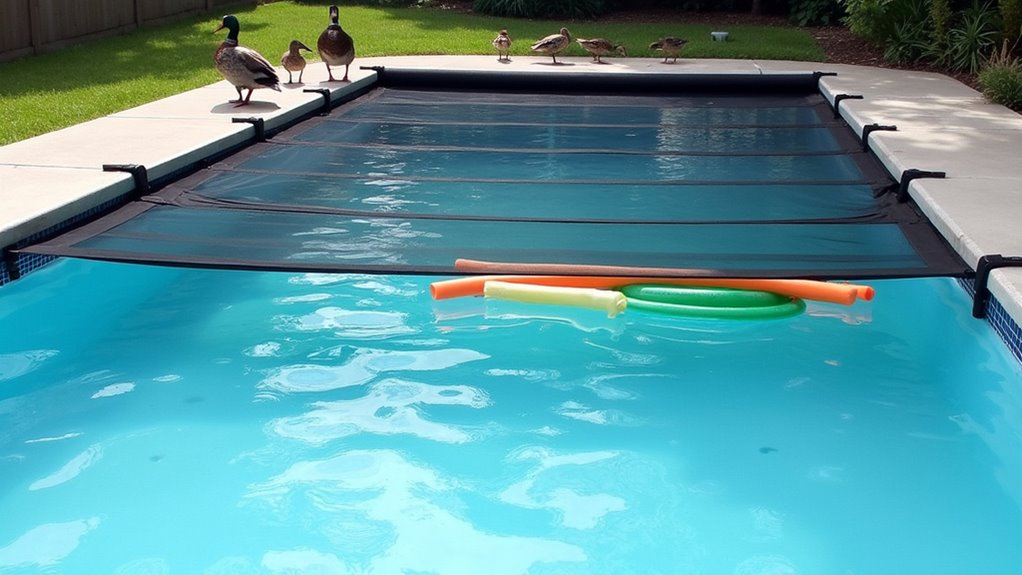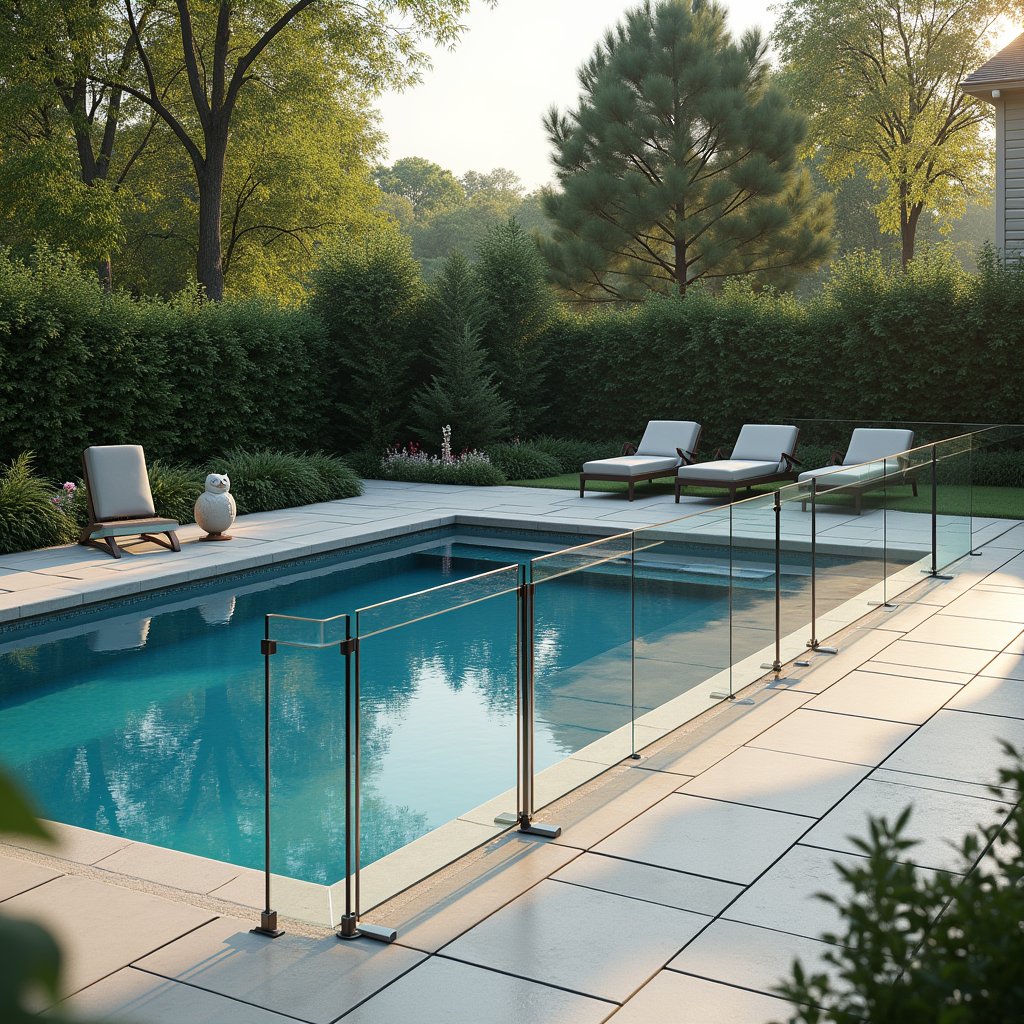To keep wildlife out of your pool, you’ll need a multi-layered approach combining physical barriers and deterrents. Install tall fencing (at least 4 feet) around your pool’s perimeter, use motion-activated sprinklers to startle approaching animals, and consider pool covers when the pool isn’t in use. Natural repellents like peppermint or citrus sprays can discourage visitors, while strategically placed decoy predators add another layer of protection. These foundational steps lead to more advanced strategies for year-round wildlife prevention.
Key Takeaways
- Install a physical barrier like tall fencing or pool netting to create an effective blockade against wildlife access.
- Set up motion-activated sprinklers around the pool area to startle and deter approaching animals.
- Place decoy predators like plastic owls near the pool, rotating their positions regularly to maintain effectiveness.
- Plant natural deterrents such as marigolds, lavender, or mint around the pool perimeter.
- Use automated sensor systems with sprays that activate during peak wildlife activity times at dawn and dusk.
Why Wildlife Is Attracted to Your Pool

Three main factors attract wildlife to your swimming pool: water, safety, and visibility.
Your pool water serves as an artificial retreat, especially in urban and suburban areas where natural water sources are limited. Birds, ducks, and other wildlife instinctively seek out water for drinking and bathing. The clear, chemical-treated water makes it easy for them to spot potential threats while using your pool.
Your pool also offers a secure wildlife habitat away from natural predators. The surrounding deck or patio provides a clear line of sight in all directions, while fencing creates a barrier against ground-based threats. Furthermore, your pool’s visibility from above makes it an easy target for passing birds, particularly during migration seasons when they’re actively searching for water sources.
Common Pool Visitors and Their Impact

While many types of wildlife may visit your pool, ducks and geese are typically the most frequent and problematic guests. Their duck behavior includes swimming, defecating, and even nesting near your pool, creating unsanitary conditions that can affect water chemistry and filtration systems.
Beyond waterfowl, you’ll likely encounter other wildlife habits around your pool. Raccoons and opossums may drink from it or hunt for insects along the edges. Frogs and toads often make themselves at home in pool areas, while snakes might follow them seeking prey. Even deer may stop by for a drink, potentially damaging pool equipment or landscaping.
These visitors can introduce bacteria, parasites, and debris into your pool water, requiring supplementary maintenance and chemical treatments to maintain safe swimming conditions.
Physical Barriers and Deterrent Methods

Installing physical barriers offers the most reliable defense against unwanted pool visitors. Your initial consideration should be fence installation around the pool’s perimeter, using materials that are both durable and tall enough to prevent animals from jumping over. Choose fencing that’s at least 4 feet high with minimal gaps between slats.
For supplementary protection, investigate different netting options that can cover your pool when it’s not in use. You’ll find both permanent and removable pool covers designed specifically to keep wildlife out while maintaining safety standards. Install motion-activated sprinklers around the pool area to startle and deter approaching animals. Place decoy predators, like plastic owls or coyotes, strategically around your pool area, but remember to reposition them regularly to maintain effectiveness.
Natural Repellents and Eco-Friendly Solutions
Natural repellents provide an environmentally conscious approach to deterring ducks and other wildlife from your pool area. You can create effective herbal sprays using peppermint, citrus, or vinegar solutions that won’t harm the animals but will make your pool space less appealing to them. Simply spray these mixtures around the pool’s perimeter weekly or after rain.
Consider planting natural scents that wildlife typically avoid, such as marigolds, lavender, or mint around your pool area. These plants serve dual purposes – they’ll beautify your surroundings while naturally deterring unwanted visitors. You can also place cotton balls soaked in essential oils like peppermint or citronella in strategic locations around your pool. These natural solutions work best when combined with other deterrent methods and may need regular reapplication to maintain their effectiveness.
Automated Deterrent Systems and Technology
Advanced technology offers more consistent and hands-free solutions for keeping wildlife away from your pool. Motion sensors connected to automated sprays create an effective deterrent system that activates whenever animals approach your pool area. You’ll find these devices particularly useful during nighttime hours when manual supervision isn’t practical.
Install motion sensors at strategic points around your pool’s perimeter, focusing on common entry paths that wildlife might use. When the sensors detect movement, they’ll trigger a short burst of water spray that startles animals without harming them. You can adjust the sensitivity and spray duration to suit your specific needs. Some systems even integrate with your smartphone, allowing you to monitor activity and customize settings remotely. These automated solutions work continuously to protect your pool while requiring minimal maintenance from you.
Seasonal Strategies for Wildlife Prevention
As seasons change throughout the year, your pool protection strategy should adapt to address different wildlife patterns and behaviors. During spring migration, you’ll need heightened vigilance as waterfowl search for nesting sites. Install temporary barriers and increase the frequency of your deterrent system activation during dawn and dusk.
Make seasonal adjustments to your pool maintenance routine in fall when leaves accumulate, as debris can attract birds looking for nesting materials. Weather considerations should guide your winter preparations – if you’re using a pool cover, verify it’s properly tensioned to prevent water accumulation that might attract wildlife. In summer, maintain consistent water chemistry and remove any floating objects that could serve as makeshift rafts for small animals seeking relief from the heat.
Frequently Asked Questions
Will Chlorine or Pool Chemicals Harm Wildlife That Enters My Pool?
Yes, pool chemicals can harm wildlife. The chlorine impact on animals can cause irritation to their eyes, skin, and respiratory systems. While standard pool chemistry isn’t immediately lethal, prolonged exposure can be dangerous for birds, mammals, and amphibians. If you’re concerned about wildlife safety, you’ll want to maintain proper chemical levels and provide easy escape routes like pool ramps or floating devices for any creatures that accidentally enter your pool.
How Can I Safely Remove Animals That Are Already in My Pool?
When you need to remove animals from your pool, always prioritize safety for both you and the wildlife. Use proper rescue protocols, such as pool skimmers or humane traps designed for aquatic rescues. Don’t chase or corner the animals, as this can cause stress or injury. For larger wildlife, it’s best to contact local animal control or wildlife services. Once the animal is safely removed, make certain it’s released in an appropriate natural habitat nearby.
Does Homeowner’s Insurance Cover Damage Caused by Wildlife in Pools?
Your homeowner’s insurance coverage for wildlife damage to pools typically depends on your specific policy terms. While most standard policies include liability coverage, damage from wildlife might fall under a separate category. It’s best to review your policy or contact your insurance agent directly. You’ll want to document any wildlife-related incidents with photos and detailed notes to support potential claims. Consider adding specific wildlife liability coverage if you live in an area prone to animal visitors.
Should I Report Injured Wildlife Found in My Swimming Pool?
Yes, you should report injured wildlife found in your pool. Contact your local wildlife control or animal services immediately, as they’re trained to handle and rehabilitate injured animals safely. Don’t try to rescue the animal yourself, as it may be scared and dangerous. If you can’t reach local authorities, call your state’s wildlife agency or search for licensed wildlife rehabilitators in your area. Keep the animal’s location monitored until help arrives.
Can Ducks and Geese Transmit Diseases to Humans Through Pool Water?
Yes, you should be concerned about disease transmission from ducks and geese in your pool. These waterfowl can spread wildlife pathogens through their droppings, including E. coli, Salmonella, and parasites. While your pool’s chlorine will kill many germs, it doesn’t work instantly. You’ll want to maintain proper chemical levels and clean the pool thoroughly after any wildlife visits to protect yourself and your family from potential waterborne illnesses.



